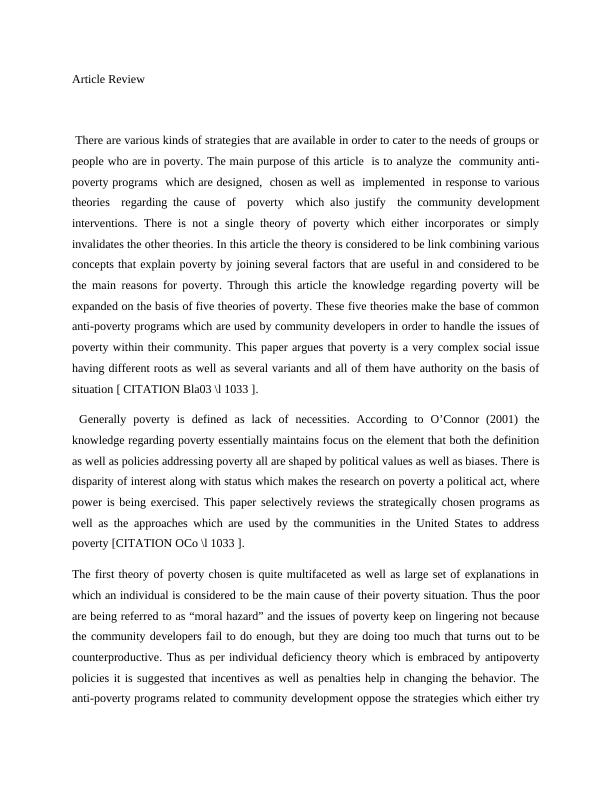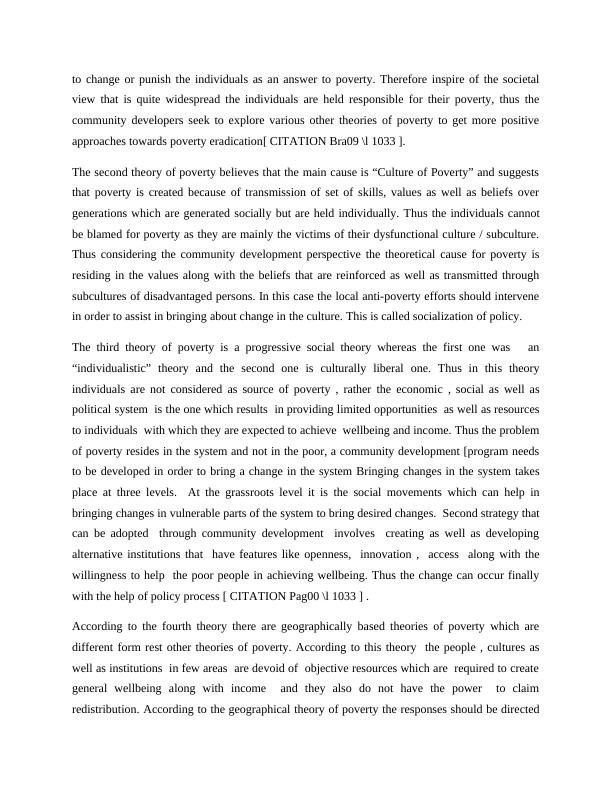Ask a question from expert
Community Anti-Poverty Programs Analysis
4 Pages1229 Words210 Views
Added on 2019-11-20
Community Anti-Poverty Programs Analysis
Added on 2019-11-20
BookmarkShareRelated Documents
Article Review There are various kinds of strategies that are available in order to cater to the needs of groups orpeople who are in poverty. The main purpose of this article is to analyze the community anti-poverty programs which are designed, chosen as well as implemented in response to varioustheories regarding the cause of poverty which also justify the community developmentinterventions. There is not a single theory of poverty which either incorporates or simplyinvalidates the other theories. In this article the theory is considered to be link combining variousconcepts that explain poverty by joining several factors that are useful in and considered to bethe main reasons for poverty. Through this article the knowledge regarding poverty will beexpanded on the basis of five theories of poverty. These five theories make the base of commonanti-poverty programs which are used by community developers in order to handle the issues ofpoverty within their community. This paper argues that poverty is a very complex social issuehaving different roots as well as several variants and all of them have authority on the basis ofsituation [ CITATION Bla03 \l 1033 ]. Generally poverty is defined as lack of necessities. According to O’Connor (2001) theknowledge regarding poverty essentially maintains focus on the element that both the definitionas well as policies addressing poverty all are shaped by political values as well as biases. There isdisparity of interest along with status which makes the research on poverty a political act, wherepower is being exercised. This paper selectively reviews the strategically chosen programs aswell as the approaches which are used by the communities in the United States to addresspoverty [CITATION OCo \l 1033 ].The first theory of poverty chosen is quite multifaceted as well as large set of explanations inwhich an individual is considered to be the main cause of their poverty situation. Thus the poorare being referred to as “moral hazard” and the issues of poverty keep on lingering not becausethe community developers fail to do enough, but they are doing too much that turns out to becounterproductive. Thus as per individual deficiency theory which is embraced by antipovertypolicies it is suggested that incentives as well as penalties help in changing the behavior. Theanti-poverty programs related to community development oppose the strategies which either try

to change or punish the individuals as an answer to poverty. Therefore inspire of the societalview that is quite widespread the individuals are held responsible for their poverty, thus thecommunity developers seek to explore various other theories of poverty to get more positiveapproaches towards poverty eradication[ CITATION Bra09 \l 1033 ].The second theory of poverty believes that the main cause is “Culture of Poverty” and suggeststhat poverty is created because of transmission of set of skills, values as well as beliefs overgenerations which are generated socially but are held individually. Thus the individuals cannotbe blamed for poverty as they are mainly the victims of their dysfunctional culture / subculture.Thus considering the community development perspective the theoretical cause for poverty isresiding in the values along with the beliefs that are reinforced as well as transmitted throughsubcultures of disadvantaged persons. In this case the local anti-poverty efforts should intervenein order to assist in bringing about change in the culture. This is called socialization of policy.The third theory of poverty is a progressive social theory whereas the first one was an“individualistic” theory and the second one is culturally liberal one. Thus in this theoryindividuals are not considered as source of poverty , rather the economic , social as well aspolitical system is the one which results in providing limited opportunities as well as resourcesto individuals with which they are expected to achieve wellbeing and income. Thus the problemof poverty resides in the system and not in the poor, a community development [program needsto be developed in order to bring a change in the system Bringing changes in the system takesplace at three levels. At the grassroots level it is the social movements which can help inbringing changes in vulnerable parts of the system to bring desired changes. Second strategy thatcan be adopted through community development involves creating as well as developingalternative institutions that have features like openness, innovation , access along with thewillingness to help the poor people in achieving wellbeing. Thus the change can occur finallywith the help of policy process [ CITATION Pag00 \l 1033 ].According to the fourth theory there are geographically based theories of poverty which aredifferent form rest other theories of poverty. According to this theory the people , cultures aswell as institutions in few areas are devoid of objective resources which are required to creategeneral wellbeing along with income and they also do not have the power to claimredistribution. According to the geographical theory of poverty the responses should be directed

End of preview
Want to access all the pages? Upload your documents or become a member.
Related Documents
Critical Social Worklg...
|10
|2364
|327
Textual Analysislg...
|7
|1416
|110
Speech Act & Theory Of Speech Acts | Assignmentlg...
|6
|1628
|202
Poverty: A Biblical and Worldview Perspectivelg...
|8
|2640
|203
Health Advocacy Assignment 2022lg...
|10
|2764
|22
Theories and Practice in Health and Social Carelg...
|8
|536
|393